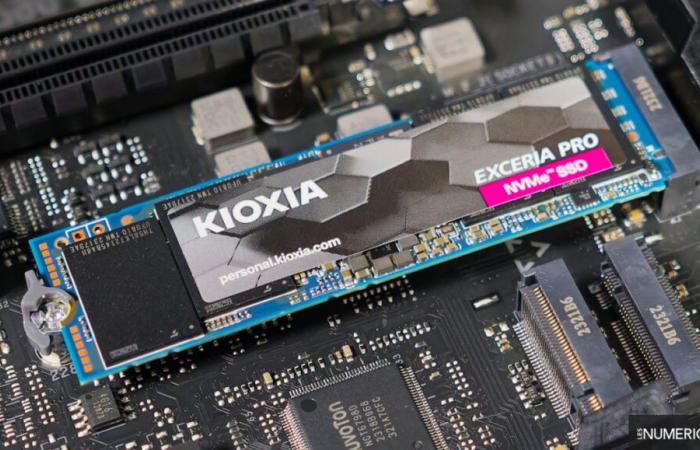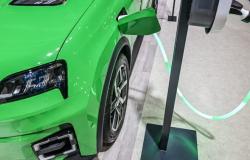Kioxia is little known to the general public since it is basically a Japanese manufacturer of NAND chips, in other words memory chips. When manufacturing chips for other manufacturers, it is also tempting to sell finished products, such as SSDs, yourself.
The Kioxia Exceria Pro is a no-frills Nvme SSD.
© Les Numériques
Kioxia therefore has a varied catalog of SSDs ranging from portable models to internal ones in NVMe format. Thus, in the Japanese range, the Exceria Pro is currently the most premium model with NVMe PCIe 4.0 compatibility that can reach speeds of 7.3 GB/s reading and 6.4 GB/s writing. This model is offered in capacities of 1 TB and 2 TB, it is the latter that we tested. The 1TB model differs slightly with a slightly higher read IOPS: 1,000,000/1,100,000 versus 800,000/1,300,000 for the 2TB version.
The absence of a heatsink allows it to be compatible with the Playstation 5.
© Les Numériques
As for the price, the 1 TB model is sold for less than a hundred euros, while its companion with 2 TB of capacity sells for around €160.
The Exceria Pro is a model with a fairly simple construction and does not benefit from a heat sink. You will therefore need to ensure that your motherboard offers M.2 NVMe slots with a radiator.
The Exceria Pro 2 TB installed on our motherboard before installing the radiator.
© Les Numériques
The warranty offered by the manufacturer is five years like the vast majority of the competition. Endurance is announced at 400 TB for the 1 TB model and 800 TB for the 2 TB model with 1.5 million operating hours guaranteed.
Obviously, Kioxia uses in-house TLC type NAND chips accompanied by a Phison E18 controller allowing it to exceed 7 GB/s.
SLC cache management
Kioxia uses dynamic caching which allows high throughput on a significant amount of data. Thus, it is possible to write at around 5.3 GB/s on almost 35% of the capacity of the 2 TB Kioxia Exceria Pro, or 700 GB, before the throughput collapses. After 700 GB of data, the transfer rate stabilizes at just 200 MB/s. Remember that we rarely transfer 700 GB of data at once; However, if you have to do it, it will be better to try it several times.
After 35%, the speed peaks at 780 MB/s.
© Les Numériques
Thermal management
According to its internal sensors, the Exceria Pro reaches a maximum of 79°C and stabilizes at 44°C when not in use. However, we recorded nearly 97°C using our thermal camera in the absence of a dissipation radiator. It will therefore absolutely be necessary to install a radiator to prevent the SSD from reducing its speeds.
The application of a heat sink is strongly recommended.
© Les Numériques
We retested the Exceria Pro under the heatsink of the Asus ROG Crosshair X670E Hero motherboard in the PCIe 5.0 slot. Here, the SSD is much more stable thanks to a temperature not exceeding 74°C and 57°C according to our thermal camera.
The temperature of the heatsink of our motherboard affixed to the SSD does not exceed 58°C.
© Les Numériques

Performances
The reading speeds announced by Kioxia for its Exceria Pro are almost maintained with 7378 MB/s on average recorded by our measurements. On the other hand, in writing, we noted much less than expected with 4445 MB/s, or 2 GB/s less than what is claimed. We therefore find behavior quite similar to the Lexar NM790 and far from the big names such as the Samsung 990 Pro and the Kingston Fury Renegade.
In terms of the number of input/output operations (IOPS), the 2TB Exceria Pro is around a million IOPS, whether reading or writing. Oddly, we obtain the results announced by Kioxia for the 1 TB model, while the 2 TB version should manage 800,000 IOPS in reading and 1.3 million in writing. In absolute terms, this remains a very high value, worthy of the best PCIe 4.0 NVMe SSDs.
File copying under Windows allows you to achieve speeds exceeding 3.1 GB/s. Thus, our 27 GB file is copied in one go and without slowing down in less than 9 s.
Remember that to obtain the results displayed above, we had to place the SSD under a radiator in order to avoid the drop in flow rates when the operating temperatures are too high (throttling).







